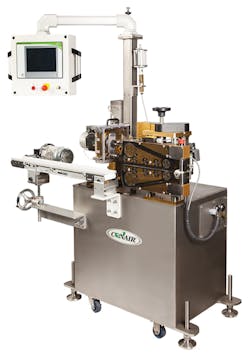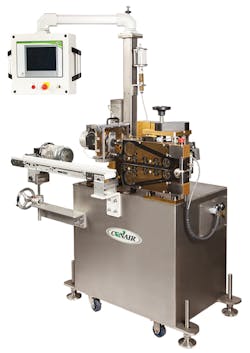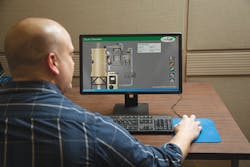Conair chief puts major focus on medical-ready equipment
Auxiliary equipment maker Conair Group, Cranberry Township, Pa., is moving aggressively in the medical market beyond downstream and into products focused on the Internet of Things (IoT).
MedLine, the company's full line of medical-ready equipment, perhaps is the biggest focus for Conair. Its launch at NPE was well-planned and orchestrated. The line's general manager, Matt Zelkovich, joined Conair roughly one year ago but his position wasn't disclosed until NPE. He came from the processing world, including 10 years as director of engineering and development with West Pharmaceutical Services Inc., Lionville, Pa. There, Zelkovich was responsible for the setup and operation of clean rooms, equipment evaluation and the validation of operations so that they can be taken
into a commercial state.
That aligned with President Larry Doyle's goal, to have Conair create a line of equipment — 170 pieces — that would be ready to operate in a clean-room environment with the calibration, validation and documentation done.
"It's being able to have the certification and being able to have it simply installed," Doyle says. "It's being able to take things off the medical processor's plate that they normally would have to do to make sure that their entire operating room is certified the right way."
For the uninitiated, clean rooms are the controlled environments where the introduction of airborne microbes, particles and chemicals is tightly monitored and controlled. These rooms are especially important in production of medical devices. It can be extremely difficult, time-consuming and expensive to equip a clean room, calibrate all the parts and validate the process according to standards and regulations under the U.S. Food and Drug Administration and ISO, the International Organization for Standardization. When it comes to purchasing primary or auxiliary equipment, a processor must undertake the arduous task of calibrating, validating and documenting it. Then the processor can get the equipment certified and start running.
The equipment in the MedLine series — including conveying and storage, resin drying, blending and heat transfer — is supplied with a quality and regulatory compliance package based on the ISO and FDA requirements. Machines are factory-calibrated to meet regulatory requirements, labeled and certified for one year. The installation qualification forms are supplied to the processor ready to be filled out and filed.
"Pretty much up to the certification point, Conair has taken care of that," says Scott Collins, Conair's spokesman. "Preconfigured, medical specifications, fully documented, already calibrated with the documentation to support the calibration. So you can bring it in, know it's going to fit in your system and it's going to pass your certification process."
ANATOMY OF A PRODUCT LINE
MedLine has been a Conair brand for nearly eight years, but now it is expanded beyond downstream. That expanding product line includes the MicroWheel desiccant dryer, TB-45 TrueBlend gravimetric blender and next-generation MedLine Material Vision Proofing distribution system, which were all on display in a simulated clean room at NPE.
Conair has worked with a lot of medical processors, Doyle says. "This is just really getting into some of those stringent clean-room applications and taking what we can offer a step further, trying to help our medical processors save time and effort so they can devote it to other things."
Conair's goal with MedLine —and with Zelkovich's position —is to offer something that the medical market wants.
"We have kept Matt undercover working on this project to get everything ready to roll out," said Doyle during an interview at NPE. "Now, Matt officially has been announced here this week and appointed our medical market general manager. His job will be to get out there and talk to these clean-room guys, find out what they need and what it is they're looking for and be able to look at what additional products we need, how do those products need to be configured, what products don't we have today that we need to invent and then design, and finally, just being able to talk to the medical processor in their language."
For Doyle, Conair's most significant product, in terms of what it achieves, happens to be a MedLine brand, though it has applications outside the medical field. The patent-pending R-PRO conveying system moves resin at a slower speed to eliminate pellet fracturing, angel hair and pipe wear caused by high-speed vacuum conveying. The system is for any processor that has angel hair issues or is conveying long distances. Where standard conveying is done at an air speed of 5,000 feet per minute, R-PRO reduces that to 300 to 600 feet per minute, Collins says.
In its mocked-up clean room, Conair had elements that represented four levels of contamination control. In a white room, products are made in an environment with standard heating, ventilating and air conditioning. Conair showed a simulated molding machine located outside of the room with high-efficiency particulate air (HEPA) filtration above the molding area. The MicroWheel desiccant dryer was mounted on the machine and the molded products were conveyed into the clean room for further processing. The desiccant dryer is compact enough to be mounted on the feed throat of a molding machine or extruder, officials said.
For its hybrid clean-room simulation, Conair showed a simulated extruder operating outside of the clean room where extruded product would exit the die and enter the clean room in a small opening in the wall. It would then go into a cooling tank and puller/cutter unit inside the clean room. Conair has redesigned the MedLine puller/cutter with an integral conveyor for use in such applications.
For illustration of the ISO Class 7 and 8 clean rooms, Conair had a ceiling with two simulated HEPA-filtered blowers that delivered air to the room. It included a simulated vertical-clamp injection molding machine with a MedLine TW Premium temperature control unit and a MedLine micro receiver mounted on the hopper of a MicroWheel dryer. The delivery of dried resin was controlled by a MedLine FLX material handling control system that had a clean touch-screen display.
In other products, MedLine's Material Vision Proofing system uses a camera to provide automatic 100 percent validation that the correct material is being conveyed to the right destination. It was set up to distribute resin from the ResinWorks system to the simulated processing machines that were displayed.
The company's TB-45 TrueBlend gravimetric blender is mounted on a floor stand. It is based on Conair's existing design but was specially configured for use in clean rooms. Officials said that depending on the application requirements, machine surfaces may be powder coated in white or made from stainless steel.
All MedLine equipment is supplied with the quality and regulatory compliance package in accordance with FDA and ISO. The machines are factory calibrated to meet regulatory requirements, labeled and certified for one year.
ADDRESSING THE INTERNET OF THINGS
Doyle believes that the Internet of Things (IoT) trend may challenge suppliers to rethink their business models. The IoT is coming on strong in manufacturing. It has been lauded in mass media as part of the next Industrial Revolution. Some call it smarter manufacturing and here is the thing: It really is up to the individual how one chooses to participate. In short, IoT represents a system where inanimate objects have their information connected and shared on the Internet through wireless or even wired connections. In the world of plastics manufacturing, that can take place in equipment, including auxiliaries.
Conair acknowledges that this is changing dramatically how machines communicate and exchange data with each other and with the people who use them. Bob Criswell, manager of electrical engineering for Conair, said that most of today's control systems are designed for Ethernet connectivity and through industrial networks and the Internet they can connect and communicate with almost any other device. They can use the technology to significantly reduce costs and increase ease of use, maintenance and integration.
Enter the products to make it happen. For Conair, IoT is represented in two products. The company showed off the third generation of its ControlWorks platform, which uses supervisory control and data acquisition technology (SCADA) to monitor and control most Conair equipment. This latest generation allows users the ability to look at more than one piece of equipment at a time, whether it is all the dryers, all the blenders or all the heat-transfer equipment. Or a user can look at all the equipment in one molding cell, for example, one dryer, one loader, and a temperature control unit. It is Web-enabled and networkable.
Data-acquisition functionality built into SCADA allows ControlWorks to gather process data from all connected equipment and store it for analysis. Under the SCADA-based system, an unlimited amount of data can be stored in a single database.
Conair's second product is a tablet-based system that can replace the human-machine interface (HMI) panels found on a lot of equipment. Conair found that a lot of people use an HMI on a certain piece of equipment primarily for setup or troubleshooting so that 90 percent of the time, the HMI just sits idle.
"It's not like you're going to go over there every day or every hour and check things," says Collins. "If there is a problem, you're going to get an alarm. You've got a full-time HMI doing a very small part-time job. Well, you don't really need it."
So Conair put the functionality in a tablet. It can program a single standard tablet computer to address the controls on multiple pieces of equipment so that it then becomes an HMI for each piece of equipment. The tablet is Internet-enabled so that it can be used to access system documentation, training and maintenance manuals and videos, instantly order spare parts or communicate with Conair as needed.
Doyle thinks that the IoT is an opportunity to increase efficiencies.
"I think that there is an opportunity for us, as suppliers of equipment and for our customers, as users of equipment, to really, really use the Internet of Things to make operations more streamlined and efficient," he says, noting that a customer recently reported to him that he wrestles with downtime.
"Anytime their machine is not squirting plastic, that is costing them money," he says. "What they are looking for from their suppliers is, 'How do I keep that downtime to a minimum?' There are a lot of ways that you can do that…follow your maintenance schedule in your manual, do your preventive maintenance, make sure you're ordering high-quality parts to replace, make sure you have a maintenance schedule, etc. That is where the IoT gets really interesting. You can have a customer have scheduled downtime, which is something they don't like as well but they have to, and then there is unscheduled downtime, which is the naughty no-no. That is where the IoT can get pretty interesting in terms of looking at, 'Hey, here is an opportunity to cut down on that unscheduled downtime. This does not look right.' You need to take a look at this, you know, throwing up flags either to the processor, and/or to the supplier as well."
In terms of major challenges, Doyle says it is going to require looking at business in a different way. Suppliers, for example, are going to have to do things that they typically wouldn't do and that still is yet to be defined.
"I can predict that something is going to go wrong, but then what? How do you notify your customer? What is the process, what are the steps? How are you going to make sure you have the inventory to support that? How are you going to make sure you have the guys working around the clock to watch the monitor? I think there are a lot of things to be defined, and there are a lot of things, quite honestly, customers are going to have to come to grips with, too. Are they going to want us to be Big Brother watching over their network?"
The benefit comes in working with the customer once the weaknesses have been identified and executing the plan once the data has been analyzed.
"That is really the payoff," he says. "It is not 'Hey, we know,' it's 'Hey, we can get you a part in under 20 hours.' "
Angie DeRosa, managing editor
Contact:
Conair Group, 724-584-5500, www.conairgroup.com


